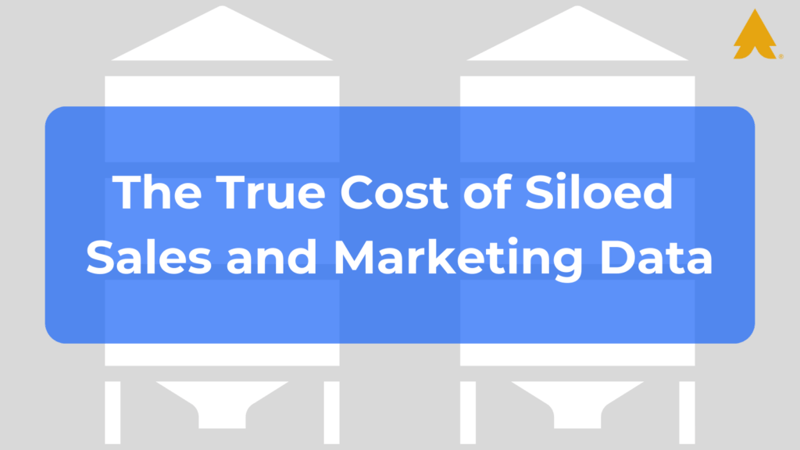How to Calculate the True Cost of Sales and Marketing Data Silos in Manufacturing
Ryan
For years, manufacturers have used tools like Lean and Six Sigma to improve their quality, boost productivity, reduce costs, and enhance the customer experience. And while these tools have significantly improved operations, there’s one area yet to address: the sales and marketing data silos in manufacturing.

How Sales and Marketing Data Become Siloed
Data silos happen when your sales, marketing, and front-office support teams use different processes and systems to gather, store, and act on data or when you have data collections unavailable to everyone who needs them.
Here are some signs you have a data silo:
- Your teams use different language to describe the same process (which tells you that they’re not collaborating on the details)
- Your departments use different systems to store data (accounting uses spreadsheets, operations use a database, and sales uses a CRM)
- Your tech stack is more than 15-20 years old and is located onsite (this creates layers of outdated or misclassified data and makes it hard to access the data you need from anywhere on any device)
- You can’t easily identify insights or report on what’s working and why (because there’s noise in the system that doesn’t need to be there)
If you see yourself in this list of signs, take heart. It’s easier than you think to get your people, processes, and technology all headed in the same direction. This post gets you started by walking you through how to calculate the true cost of siloed sales and marketing data.
How to Calculate the Cost of Sales and Marketing Data Silos
When I sit down with prospects or clients to talk about data integration, they’re usually concerned about whether investing in new tools will be revenue positive for them.
To answer that question, you first need to get clear on what it costs your company to have data in multiple places because of the issues it causes downstream. Here are a few examples.

The Effects of Data Silos in Manufacturing
Lost Leads
If you manually route leads or send leads by email, you don’t have enough visibility into your customer’s journey. And you’re probably losing some leads along the way because of it. That’s just how it goes when processes are manual.
The true cost of this data silo is when you consider the lifetime value of a customer.
Calculate your true cost: How many leads are you losing each year due to a lack of communication between sales and marketing? How many of those leads would you have converted with real-time visibility? What’s your average lifetime customer value?
Missed Opportunities
If you manually respond to marketing requests, just one delay or bad handoff can lead to a missed opportunity. And it happens all the time. Someone didn’t realize they were supposed to follow up. Or someone was on vacation, and a sample request took days to fill.
The true cost of this data silo is when you consider that deals in the manufacturing segment can easily reach into six- and seven-figure territory.
Calculate your true cost: How many opportunities come your way? How many of those could be missed due to a lack of alignment between sales and marketing? What’s your average deal size?
Decreased Revenue
If you’re struggling with slow cash or having profitability or EBITDA challenges, that’s a problem – especially if a private equity company owns you.
The true cost of this data silo is when you consider how slow cash increases your exposure and risk.
Calculate your true cost: How fast is your cash cycle? What pressure is that exposure putting on the business? How much revenue is your business missing out on due to lost leads or missed opportunities?
How Better Data Leads to Better Results
Hopefully, the chance to win more opportunities, convert more leads, and increase revenue caught your attention. But in case you still need convincing, here are some of the other benefits our manufacturing customers see when they integrate their sales and marketing data:
- Better decision-making
- Enhanced customer experience
- Reduced costs
- Improved compliance
- Employee engagement

How Can a Growth-Oriented Partner Agency Help With Data Silos in Manufacturing?
We’ve seen how often this decision gets companies wrapped around the ax handle. And we get it. This is a big undertaking. But whether we work together or not, I hope you’ll at least just get started. This work really is that important.
If you are looking for guidance, here are some ways Lake One’s experience might be helpful:
- Creating a unified language – we can help you get all the right people in the room and get aligned on what you’re trying to accomplish.
- Merging, integrating, and cleaning your data – we can create a plan to merge your data from different sources into a single, consistent format that meets everyone’s needs.
- Analyzing and reporting your data – we can show you how to identify trends and patterns in your data that can help you make better decisions. And we can help you create reports that help your sales and marketing teams understand what’s working and what’s not.
- Evaluating platforms – while HubSpot is our weapon of choice, a lot of the advice and counsel we offer manufacturing companies is platform agnostic. That means we can help you identify essential processes, gather requirements and evaluate a range of platforms, including HubSpot.
- Providing transition support – big transformational changes aren’t easy, and they don’t happen overnight. We can help you break this work into smaller pieces that are easier to tackle and cheer you on throughout the process.
Say Goodbye to Data Silos With Lake One
If you want to talk through some true cost scenarios, feel free to give us a holler. We sure enjoy the chance to geek out with new friends about sales and marketing data!

